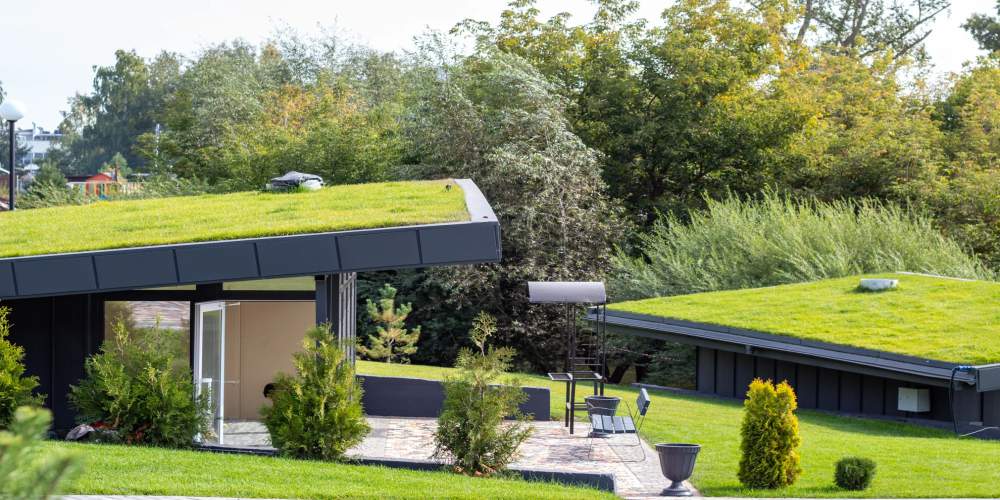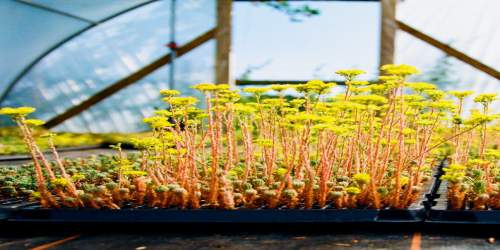Read Time : 3 Minutes
What is a Green Roof / Sedum Roof
A green roof is the roof of a building that is in part or wholly covered with living vegetation, normally planted on top of a protective plastic layer. They are generally more popular in both the United States and the rest of Europe rather than here in the UK but they offer a number of benefits both for the environment and the efficient heating and cooling of a house. Green roofing has become very popular in many major cities and densely populated areas where the addition of green spaces is often seen as a panacea for the concrete jungle. In New York it has been used as a remedy for the flooding caused by heavy rainfall at certain times of the year and in Mexico they are using azoteas verdes as a combative measure against growing pollution. Essentially, green roofs add vegetation into urban areas without disrupting the architecture, making something useful out of a space that is often neglected. They can be large or small but they all offer a range of benefits, from reducing energy bills with natural insulation, create relaxing spaces for people and habitats for animals, large and small, and can also reduce the impact of storms by absorbing water. Green roofs can be employed on new builds, older houses and offices, on top of skyscrapers and garage tops, in fact anywhere there is a roof. They are a cost effective and pleasant way to improve the environment: Green roofs can serve many purposes, such as:
COMPARE PRICES FROM LOCAL INSTALLERS
Compare prices from local companies fast & free
Enter your postcode to compare quotes from leading professionals. We promise to keep your information Safe & Secure. Privacy Policy
- Energy saving properties in both summer and winter (through their insulating effect).
- The absorption of rainwater.
- The absorption of carbon dioxide and pollutants and an improvement of local air quality.
- Mitigation of the ‘urban heat island’ effect present in large cities (this refers to the higher temperature in urban areas than in rural areas due to human activity - typically around 4°C more).
- Creation of habitats for fauna and growing food.
- Positive aesthetic impact on those who live in the area.
- Sound insulation - green roofs can tone down the hammering of rainfall and other noise.
- Use of roof space for leisure activities - some roofs may be suitable for gardens which can be physically accessed.
- Long term protection for the roof, which leads to a greater lifespan.
Green roofs aren’t a new idea, they’ve existed for thousands of years in one form or another and they were a popular form of roofing in Scandinavian countries for centuries. More recently, the Germans developed them further in the 1960s and estimates suggest over 10% of their roofs have been now been ‘greened’. Nowhere is this more evident than in the capital Berlin where research has been carried out on how green roofs reduce the surrounding temperature and produce a more pleasant environment.
Intensive and Extensive Green Roofs
The types of green roofs are usually divided between intensive and extensive. Intensive roofs are deeply soiled and can accommodate a wide range of plants, including, in larger developments, trees. Because of the weight, they require greater support underneath and can incorporate water management systems that can help with recycling. They are a little more labour intensive than other designs. Extensive green roofs have a shallow layer of soil over a bigger area which means they are not suited to all plant types but are ideal for a wider range of roofs because they are lighter and need less structural support. For this reason they are often the type of green roof that is retrofitted to an existing building. They are also lower maintenance than their intensive counterparts. One area that is beginning to grow in popularity is the development of bio-diverse or wildlife roofs that are designed to suit a particular species, for instance to encourage certain insects that birds can feed upon. One example is the Laban Conservatoire of Music and Dance in London that was created to attract rare birds such as the black redstart.
Is Your Roof Suitable for a Garden?
As long as your roof has a slope of less than 30° it can support some kind of roof garden. The type will depend on the underlying structure which may well have to be strengthened to accommodate the extra load. Green roofs don’t have to applied to the whole roof, it can be done in part, where you think suitable, and is an easy way to help the environment and increase the efficiency of your house at the same time. The only problem is that it needs to be readily accessible if you want to keep it looking in pristine condition without having to climb up a ladder. Find out if your roof is suitable here.
The Best Roof Gardens
The Sky Garden House in Singapore: Stretching over 852 square metres the house can be found on Sentosa Island and comprises a number of smaller gardens in one environment. Brussels wrap around: If you want a house that is totally green in the most unusual sense then this house in Brussels may well be what you are looking for. New York Skylines: If you want to see how New York has taken to green roofs then take a look at these aerial pictures of the Big Apple. If you want to explore the possibility of creating a green roof for your property, check out our comprehensive guide to how they work.
Find a local installer
Welcome to the biggest directory of UK renewable energy companies





 How do Green Roofs Work
How do Green Roofs Work





